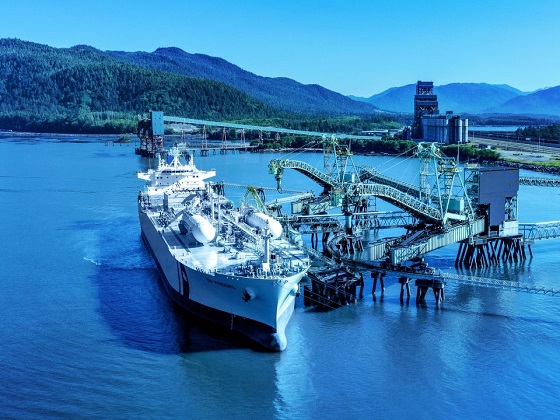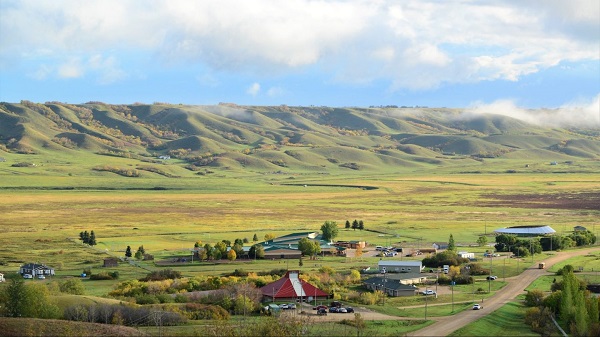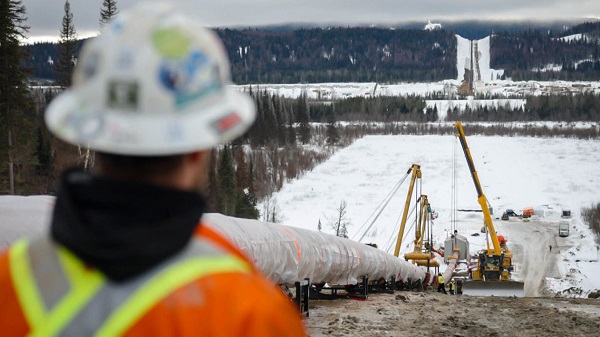Canadian Energy Centre
Canadian renewable propane could be a fuel of the future

From the Canadian Energy Centre
‘We want to make sure we reduce emissions while keeping in mind affordability and reliability’
Four years ago, Craig Timmermans’ two Ontario radio stations became Canada’s first to go on the air from off the grid.
Faced with an $80,000 connection fee and ongoing electricity delivery costs, Timmermans opted for another solution: solar and propane.
“I did our power calculation: five staff, hot water tank, heating system, etc., right down to a coffee maker…then we need a heating source, so it made sense to go with propane,” he said.
“When I looked at all the different heating systems, I found that propane is hands down the most efficient.”
Now Timmermans is building a new home that will run exclusively on propane. He says he wanted propane appliances due to their efficiency.
Ontario radio operators KT and Craig Timmermans power their off-grid business with propane and solar. Photo supplied to the Canadian Energy Centre
“A propane cooking stove is the best cooking appliance…The heat is continuous, it’s instant. It just works so well.”
Lower environmental footprint
Propane serves many purposes in Canada, from supporting mining and oil and gas operations to fueling heating, cooling, cooking and power in remote, off-grid communities.
In these communities, propane can replace diesel with a lower environmental footprint. Propane’s carbon intensity is estimated at 72 grams of CO2 equivalent per megajoule, compared to 100 grams for diesel.
That could be slashed by more than half with a move to renewable propane, according to the Canadian Propane Association (CPA). The CPA has commissioned a new report that looks at potential pathways to producing renewable propane in Canada.
 Propane storage tank. Getty Images photo
Propane storage tank. Getty Images photo
Pairing with heat pumps and hybrid energy systems
The report serves as the foundation of the CPA’s roadmap for scaling up renewable propane production in Canada.
The CPA says the fuel is ideal for pairing with electric heat pumps to provide back-up heat in low temperatures, especially in remote regions that are not near natural gas grids.
It’s also promising for hybrid systems where solar or wind provides baseload energy and renewable propane provides support when renewables are not available.
Part of propane’s appeal – renewable or otherwise – is that it’s easily liquefied and stored in pressurized cylinders, making it a versatile energy source used almost anywhere, the CPA says.
“We want to make sure we reduce emissions while keeping in mind affordability and reliability as key pillars in any energy transformation,” said CEO Shannon Watt.
“Propane goes where other fuels can’t go.”
Producing renewable propane
Today, most propane produced in Canada comes as a byproduct from natural gas processing.
Among other sources, renewable propane can be co-produced with renewable diesel and sustainable aviation fuel, made primarily from plant and vegetable oils, animal fats or used cooking oil.
Cost is the barrier to renewable propane production – about double what it takes to produce conventional propane, the CPA says.
The United States is offering incentives for renewable propane that are not available in Canada.
Through the Inflation Reduction Act, Renewable Fuel Standard and Low Carbon Fuel Standard, renewable propane producers can receive C$20 per gigajoule (or more than C$30 per GJ in California).
Through Canada’s Clean Fuel Regulations, the incentive is just over C$5 per GJ, or about C$10 per GJ in British Columbia.
“In order to attract investment the same way as the U.S. under the Inflation Reduction Act, we need to have competing measures in place,” Watt said.
“We’ve got the technology and we’ve got the feedstocks. We’ve got a lot of those big puzzle pieces that we need. Now we need the dollars to flow.”
 The Ridley Island Export Terminal in Prince Rupert, B.C. ships Canadian propane to overseas markets. Photo courtesy AltaGas
The Ridley Island Export Terminal in Prince Rupert, B.C. ships Canadian propane to overseas markets. Photo courtesy AltaGas
Exporting renewable propane to the world
A large-scale renewable propane industry wouldn’t just benefit Canadians, she said.
That’s because global demand for propane is growing.
Market research firm IMARC Group projects world propane use will rise to nearly 250 million tonnes by 2032, more than one-third higher than demand last year.
The transition to cleaner energy sources is a major factor propelling growth, analysts said.
Until recently, Canada’s only propane exports went to the United States. That changed with the startup of two export terminals at Prince Rupert, B.C.
Since 2017, Canada’s propane exports outside the U.S. have grown substantially, reaching 42 per cent of total propane exports in 2023, according to the Canada Energy Regulator.
“We export more and more propane to non-U.S. locations,” Watt said.
“Now, roughly 50 per cent of Canadian propane is shipped to South Korea, Japan and Mexico, displacing higher emission intensity sources, namely coal and timber.”
Exporting renewable propane would take the benefits a step further, she said.
“That carries the conversation on about reducing global emissions and not just what’s happening in our own backyard.”
Canadian Energy Centre
Saskatchewan Indigenous leaders urging need for access to natural gas

Piapot First Nation near Regina, Saskatchewan. Photo courtesy Piapot First Nation/Facebook
From the Canadian Energy Centre
By Cody Ciona and Deborah Jaremko
“Come to my nation and see how my people are living, and the struggles that they have day to day out here because of the high cost of energy, of electric heat and propane.”
Indigenous communities across Canada need access to natural gas to reduce energy poverty, says a new report by Energy for a Secure Future (ESF).
It’s a serious issue that needs to be addressed, say Indigenous community and business leaders in Saskatchewan.
“We’re here today to implore upon the federal government that we need the installation of natural gas and access to natural gas so that we can have safe and reliable service,” said Guy Lonechild, CEO of the Regina-based First Nations Power Authority, on a March 11 ESF webinar.
Last year, 20 Saskatchewan communities moved a resolution at the Assembly of First Nations’ annual general assembly calling on the federal government to “immediately enhance” First Nations financial supports for “more desirable energy security measures such as natural gas for home heating.”
“We’ve been calling it heat poverty because that’s what it really is…our families are finding that they have to either choose between buying groceries or heating their home,” Chief Christine Longjohn of Sturgeon Lake First Nation said in the ESF report.
“We should be able to live comfortably within our homes. We want to be just like every other homeowner that has that choice to be able to use natural gas.”
At least 333 First Nations communities across Canada are not connected to natural gas utilities, according to the Canada Energy Regulator (CER).
ESF says that while there are many federal programs that help cover the upfront costs of accessing electricity, primarily from renewable sources, there are no comparable ones to support natural gas access.
“Most Canadian and Indigenous communities support actions to address climate change. However, the policy priority of reducing fossil fuel use has had unintended consequences,” the ESF report said.
“Recent funding support has been directed not at improving reliability or affordability of the energy, but rather at sustainability.”
Natural gas costs less than half — or even a quarter — of electricity prices in Alberta, British Columbia, Ontario, Manitoba and Saskatchewan, according to CER data.
“Natural gas is something NRCan [Natural Resources Canada] will not fund. It’s not considered a renewable for them,” said Chief Mark Fox of the Piapot First Nation, located about 50 kilometres northeast of Regina.
“Come to my nation and see how my people are living, and the struggles that they have day to day out here because of the high cost of energy, of electric heat and propane.”
According to ESF, some Indigenous communities compare the challenge of natural gas access to the multiyear effort to raise awareness and, ultimately funding, to address poor water quality and access on reserve.
“Natural gas is the new water,” Lonechild said.
Alberta
The beauty of economic corridors: Inside Alberta’s work to link products with new markets

From the Canadian Energy Centre
Q&A with Devin Dreeshen, Minister of Transport and Economic Corridors
CEC: How have recent developments impacted Alberta’s ability to expand trade routes and access new markets for energy and natural resources?
Dreeshen: With the U.S. trade dispute going on right now, it’s great to see that other provinces and the federal government are taking an interest in our east, west and northern trade routes, something that we in Alberta have been advocating for a long time.
We signed agreements with Saskatchewan and Manitoba to have an economic corridor to stretch across the prairies, as well as a recent agreement with the Northwest Territories to go north. With the leadership of Premier Danielle Smith, she’s been working on a BC, prairie and three northern territories economic corridor agreement with pretty much the entire western and northern block of Canada.
There has been a tremendous amount of work trying to get Alberta products to market and to make sure we can build big projects in Canada again.
CEC: Which infrastructure projects, whether pipeline, rail or port expansions, do you see as the most viable for improving Alberta’s global market access?
Dreeshen: We look at everything. Obviously, pipelines are the safest way to transport oil and gas, but also rail is part of the mix of getting over four million barrels per day to markets around the world.
The beauty of economic corridors is that it’s a swath of land that can have any type of utility in it, whether it be a roadway, railway, pipeline or a utility line. When you have all the environmental permits that are approved in a timely manner, and you have that designated swath of land, it politically de-risks any type of project.
CEC: A key focus of your ministry has been expanding trade corridors, including an agreement with Saskatchewan and Manitoba to explore access to Hudson’s Bay. Is there any interest from industry in developing this corridor further?
Dreeshen: There’s been lots of talk [about] Hudson Bay, a trade corridor with rail and port access. We’ve seen some improvements to go to Churchill, but also an interest in the Nelson River.
We’re starting to see more confidence in the private sector and industry wanting to build these projects. It’s great that governments can get together and work on a common goal to build things here in Canada.
CEC: What is your vision for Alberta’s future as a leader in global trade, and how do economic corridors fit into that strategy?
Dreeshen: Premier Smith has talked about C-69 being repealed by the federal government [and] the reversal of the West Coast tanker ban, which targets Alberta energy going west out of the Pacific.
There’s a lot of work that needs to be done on the federal side. Alberta has been doing a lot of the heavy lifting when it comes to economic corridors.
We’ve asked the federal government if they could develop an economic corridor agency. We want to make sure that the federal government can come to the table, work with provinces [and] work with First Nations across this country to make sure that we can see these projects being built again here in Canada.
-

 2025 Federal Election2 days ago
2025 Federal Election2 days agoPoilievre To Create ‘Canada First’ National Energy Corridor
-

 International2 days ago
International2 days agoFREE MARINE LE PEN!’: Trump defends French populist against ‘lawfare’ charges
-

 COVID-191 day ago
COVID-191 day agoMaxime Bernier slams Freedom Convoy leaders’ guilty verdict, calls Canada’s justice system ‘corrupt’
-

 Automotive2 days ago
Automotive2 days agoDark Web Tesla Doxxers Used Widely-Popular Parking App Data To Find Targets, Analysis Shows
-

 Censorship Industrial Complex1 day ago
Censorship Industrial Complex1 day agoChina announces “improvements” to social credit system
-

 Carbon Tax1 day ago
Carbon Tax1 day agoThe book the carbon taxers don’t want you to read
-

 Business2 days ago
Business2 days agoWill Trump’s ‘Liberation Day’ Tariffs End In Disaster Or Prosperity?
-

 International1 day ago
International1 day agoGermany launches first permanent foreign troop deployment since WW2









